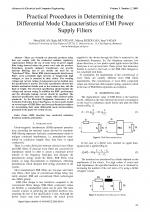| 2/2009 - 10 |
Practical Procedures in Determining the Differential Mode Characteristics of EMI Power Supply FiltersBALAN, H. |
| Extra paper information in |
| Click to see author's profile in |
| Download PDF |
Author keywords
EMI, insertion loss, conducted emissions, frequency analysis, attenuation
References keywords
electromagnetic(5)
No common words between the references section and the paper title.
About this article
Date of Publication: 2009-06-02
Volume 9, Issue 2, Year 2009, On page(s): 65 - 69
ISSN: 1582-7445, e-ISSN: 1844-7600
Digital Object Identifier: 10.4316/AECE.2009.02010
Web of Science Accession Number: 000268723600010
SCOPUS ID: 70349184078
Abstract
There are virtually no electronic products today that can comply with the conducted emission regulatory requirements without the use of some form of power supply filter being inserted where the power cord exits the product. Sometimes, properly designed transformers can provide inherent filtering, and so can obviate the need for an intentional filter. Mains EMI (electromagnetic interference) filters carry potentially high currents at dangerously high voltages, so care is essential in their choice. The working voltage and current rating of components can be decided once the specification is known. The basic specification should also include mechanical details such as the enclosure size, and the limit of weight. The electrical specification should include the voltage and current rating. In addition the EMC performance and the allowable leakage current should be specified. The electrical specification must also comply with national safety standards. In the Electrical Equipment Laboratory of the Technical University from Cluj-Napoca, we have made studies on several types of EMI filters and have performed procedures for determining their main differential mode characteristics, presented in the paper for a study of case. |
| References | | | Cited By «-- Click to see who has cited this paper |
| [1] Arcotronics Ltd, Product catalogue
[2] CEEX 77/2006 Analysis and calculus system of the signals in polluted networks [3] Buzdugan, M., "Contributions on the study of the electromagnetic interference on low voltage networks", PhD Thesis, Technical University from Cluj-Napoca, 2007 [4] Paul, C., R., "Introduction to Electromagnetic Compatibility", John Wiley & Sons, Inc., 2006 [PermaLink] [5] Ozenbaugh, R. L., "EMI Filter Design", Marcel Dekker, Inc., 2001 [PermaLink] [6] Gerfer, A., Ralf, B., Zenker, H., "Trilogy of Inductors", Swiridoff Verlag, 2002 [7] EN 55011: 2007 Industrial, scientific and medical (ISM) radiofrequency Equipment; Electromagnetic disturbance characteristics. Limits and methods of measurement [8] EN61000-4: 2004 Electromagnetic Compatibility (EMC) Part 4: Testing and measurement techniques [9] Winder, S., "Analog and Digital Filter Design", Elsevier Science, 2002 [PermaLink] [10] M.I. Buzdugan, E.I. Simion, T.I. Buzdugan, "An electromagnetic interference problem via the main distribution networks", Advances in Electrical and Computer Engineering, vol. 7, no. 2, pp. 59-62, 2007 [CrossRef] [Full Text] [11] Williams, T., "EMC for Product Designers", Newnes, 2007 [PermaLink] [12] EMC&Inductive Solutions, Wurth Elektronik, 2006/2007 [13] Line impedance stabilization network HM-6050-2, User manual, Hameg Instruments [14] Spectrum analyzer HM 5014, User manual, Hameg Instruments [15] F. Z. Peng, "Harmonic Sources and Filtering Approaches", IEEE Industry Applications Magazine, pp.18-25, Jul-Aug 2001 [CrossRef] [SCOPUS Times Cited 341] [16] LISN Model 4810 Manual, ETS-LINDGREN; [17] SW 5012 E-V147 Software Operating Instructions, Hameg Instruments Web of Science® Citations for all references: 0 SCOPUS® Citations for all references: 341 TCR Web of Science® Average Citations per reference: 0 SCOPUS® Average Citations per reference: 20 ACR TCR = Total Citations for References / ACR = Average Citations per Reference We introduced in 2010 - for the first time in scientific publishing, the term "References Weight", as a quantitative indication of the quality ... Read more Citations for references updated on 2025-06-30 17:31 in 16 seconds. Note1: Web of Science® is a registered trademark of Clarivate Analytics. Note2: SCOPUS® is a registered trademark of Elsevier B.V. Disclaimer: All queries to the respective databases were made by using the DOI record of every reference (where available). Due to technical problems beyond our control, the information is not always accurate. Please use the CrossRef link to visit the respective publisher site. |
Faculty of Electrical Engineering and Computer Science
Stefan cel Mare University of Suceava, Romania
All rights reserved: Advances in Electrical and Computer Engineering is a registered trademark of the Stefan cel Mare University of Suceava. No part of this publication may be reproduced, stored in a retrieval system, photocopied, recorded or archived, without the written permission from the Editor. When authors submit their papers for publication, they agree that the copyright for their article be transferred to the Faculty of Electrical Engineering and Computer Science, Stefan cel Mare University of Suceava, Romania, if and only if the articles are accepted for publication. The copyright covers the exclusive rights to reproduce and distribute the article, including reprints and translations.
Permission for other use: The copyright owner's consent does not extend to copying for general distribution, for promotion, for creating new works, or for resale. Specific written permission must be obtained from the Editor for such copying. Direct linking to files hosted on this website is strictly prohibited.
Disclaimer: Whilst every effort is made by the publishers and editorial board to see that no inaccurate or misleading data, opinions or statements appear in this journal, they wish to make it clear that all information and opinions formulated in the articles, as well as linguistic accuracy, are the sole responsibility of the author.



